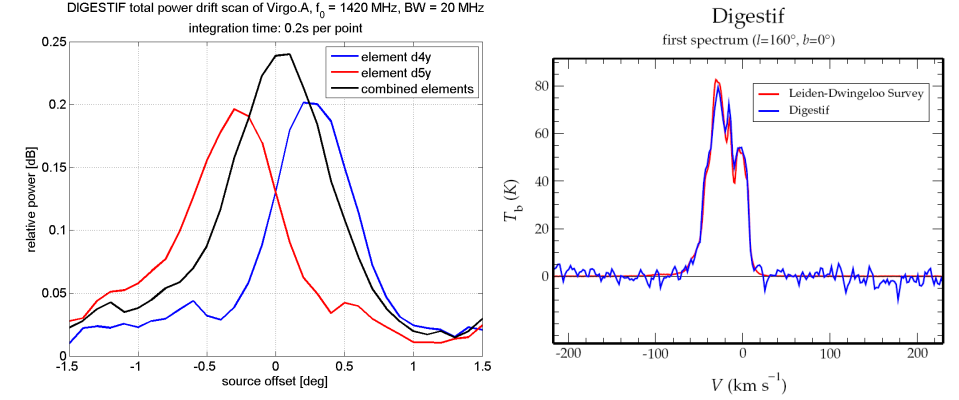Daily Image
03-09-2007First light DIGESTIF
| Submitter: | Wim van Cappellen, Tom Oosterloo |
| Description: | First astronomical detections have been made with the DIGESTIF demonstrator. DIGESTIF is the first digital focal plane array (FPA) prototype of the APERTIF system. The left figure shows a total power driftscan through Virgo.A. The blue and red curves represent the total power integrated over a 20 MHz band around 1420 MHz of two elements around the geometrical focus. Since these elements are not in the geometrical focus, their beam is offset with respects to the telescope axis. However, after calibration, both beams can be combined in-phase such that a single on-axis beam is formed (black). This resulting beam also has an increased sensitivity compared to the beams of the single elements. This illustrates the key principle of FPA beam forming. Figure 1 (right) shows that the system is working properly: it shows neutral hydrogen of the Galaxy detected by DIGESTIF and is compared to a spectrum from the Leiden-Dwingeloo survey. The correspondence is striking. Focal plane arrays aim to substantially improve the field of view of reflector radio telescopes and are one of the technologies under consideration for the Square Kilometer Array (SKA). Such larger field of view will enable completely new types of astronomical research. The objective of DIGESTIF is to test and evaluate beam forming, calibration and imaging of focal plane arrays. DIGESTIF is integrated into one of the 25 m Westerbork telescopes. A 112 element dual polarised Vivaldi array is mounted in the focus box. After amplification in the feedbox, 60 analog signals are transported to the backend, which is located in a shielded cabin next to the telescope. The RF signals are down-converted and digitized by 60 receiver units. The receivers sample at 80 MHz using 12 bit ADCís. The raw digital data is stored into RAM buffers and further processed offline. This setup offers an enormous flexibility since the weighting factors of the elements can be applied afterwards. This allows optimisation of the beamformer weights in software without re-measuring. These initial results are an excellent starting point for the planned beam forming, calibration and imaging studies. |
| Copyright: | ASTRON, 2007. |
| Tweet |  |
